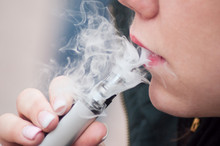Article: Effects of E-cigarette E-liquid components on bronchial epithelial cells: Demonstration of dysfunctional efferocytosis
Respirology. 2020 Jun;25(6):620-628. Epub 2019 Sep 22.
doi: 10.1111/resp.13696
https://onlinelibrary.wiley.com/doi/full/10.1111/resp.13696
Authors:
Miranda P Ween 1 2 , Rhys Hamon 1 2 , Matthew G Macowan 1 2 , Leigh Thredgold 3 , Paul N Reynolds 1 2 , Sandra J Hodge 2
Affiliations:
1 Department of Thoracic Medicine, Royal Adelaide Hospital, Adelaide, SA, Australia.
2 School of Medicine, University of Adelaide, Adelaide, SA, Australia.
3 Department of Occupational and Environmental Health, School of Public Health, University of Adelaide, Adelaide, SA, Australia.
Funders:
M.P.W. has received research funding from the Royal Adelaide Hospital for this study.
Aim:
The ingredients in e-cigarettes (“vaping”) are thought to damage cells in the airways and their function. E-cigs are promoted as a safer alternative to normal cigarettes, however, there is little data to show how the vapour could affect non-smokers.
As more young people take up vaping, this uncertainty is worrying. The research team hoped to investigate the impact of e-cig chemicals on airway cells.
Terminology:
E-cigarette: A device that produces vapour for smoking
Bronchial epithelial cells: The outer-most layer of cells in the bronchi, which is a passage that air travels through to reach the lungs
Cytokines: Molecules produced by cells to help regulate the immune response, allow cells to talk to each other and move around.
Efferocytosis: The process where dying cells are consumed by phagocytic cells
Apoptosis: Death of cells
Macrophages: Phagocytic / white blood cells that help eat up bacteria and other foreign organisms to protect the body from illness
Method:
A range of mini experiments were carried out to look at how airway (bronchial) cells are changed by e-cig components: 3 liquid apple flavours, nicotine, vegetable glycerine and propylene glycol. The EVOD-2 Vape device was used to create a realistic set-up.
Human bronchial cells were treated with control media (no cigarette/e-cig smoke), 10% cigarette smoke extract, 100% e-cig extract or 1um of paclitaxel (anti-cancer drug):
• This was followed by an LDH assay, which helps identify the level of cell damage by measuring enzymes released by injured cells
• Death (apoptotic) markers were detected using antibodies on THP-1 macrophages
• Cell death in bronchial epithelial cells was spotted using Annexin V and Sytox Green staining
• THP-1 macrophages treated with e-cig extract were incubated with dying human bronchial epithelial cells to see if the e-cigs stop macrophages from undertaking their normal job of consuming dying cells (efferocytosis)
• Inflammatory markers (TNF-alpha, interferon, interleukins) were determined using antibodies via cytometric bead assay
• The surrounding cell media was tested for DNA released by cells
Results:
• Two out of three apple flavours caused significant damage to cells (36-40%) compared to controls (12%).
• E-cig extract caused notable cell death, decreased macrophage ability to eat up dying cells and reduced expression of cell death markers
• E-cigarette components affected the production of a range of cell cytokines: e-cig extract and glycol bases significantly reduced the production of TNF-alpha, e-cig extract reduced IL-6, apple flavours reduced MIP-alpha and MIP-beta. Nicotine alone and the e-cig extract lowered IP-10.
• Apple flavour 2 and 3 caused DNA to be released by cells
Conclusions:
E-cigarettes are potentially harmful to cells in the airways. Their components alter bronchial cells and affect their normal functioning ability which could lead to dysfunction and disease in humans.
Relevance:
A growing number of studies are investigating the impact of e-cigarettes which have become trendier in recent years. These studies have considered survival of airway cells under e-cig conditions, however, there is limited research into the underlying mechanisms, specifically through regulated cell death (apoptosis).
This is the first study to show that e-cig extract causes cell death (apoptosis) in bronchial epithelial cells. It is also the first study to identify how e-cigs change the markers/receptors on macrophage cells that reduces their ability to recognise dying cells and clear them away. Greater loss of bronchial cells can also give rise to inflammatory conditions in the airways.
These changes to airway cells, cell functionality and inflammation caused by e-cigs are all known factors that could accelerate lung disease in humans. Recognising these dangers are important when creating evidence-based public health messages and in the regulation of products and advertisements. Studies like this provide vital information, especially as increased numbers of young people take up vaping.
HRA Comment:
Sadly, animals such as mice, rats and dogs are still being forcibly exposed to smoke as a way of testing new and existing brands of smoking products. Not only are these testing conditions cruel to animals, but also un-necessary. Studies such as this one, show that it is possible to consider the impact of smoking products in a human-like setting. As the method involves human cells, the results are also more applicable to human health.
Although this study does not directly use any animals it was noted that antibodies and serum with animal hosts were utilised.

